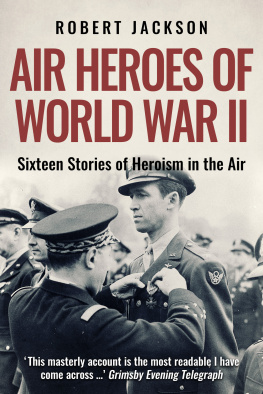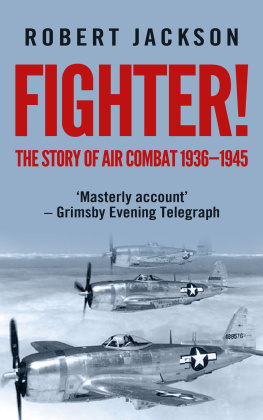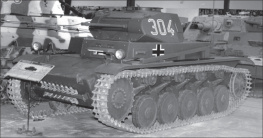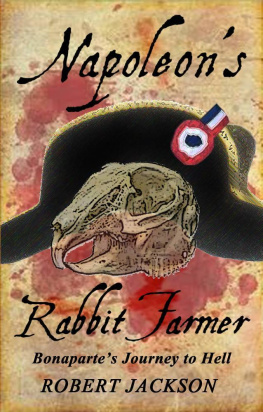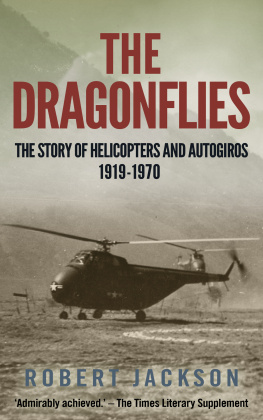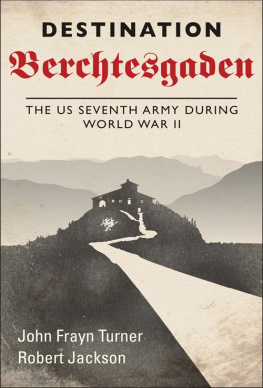Air Heroes of World War II
Sixteen Stories of Heroism in the Air
Robert Jackson
Robert Jackson 1978
Robert Jackson has asserted his rights under the Copyright, Design and Patents Act, 1988, to be identified as the author of this work.
First published in 1978 by Arthur Barker Limited.
This edition published in 2017 by Endeavour Press Ltd.
Table of Contents
Introduction
THE STORY OF THE SECOND WORLD WAR IS THE story of ordinary people performing extraordinary feats, often with great courage.
Nowhere was this more true than in the air, where technical troubles and the weather caused as many problems as the enemy.
This book tells of courage in the air, from a valiant low-level attack by RAF bombers on the German fleet on the second day of the war to a suicidal, lone dive against a Japanese destroyer by a navy pilot when the war was almost over.
The stories in between show courage in all its manifestations. The Russian pilot who crawled through the snow for nineteen days with no feet; the men who risked their lives night after night in flimsy aircraft to land agents in occupied Europe; the film star who saved an American bomber squadron from destruction; the German pilot who ordered ss officers from his aircraft at gunpoint in order to save wounded soldiers; French bomber crews who had the agonizing task of bombing their own capital city all these and other true tales tell of men who became heroes in their own way, in the sky between 1939 and 1945.
1 - FIRST STRIKE
When World War n broke out , the RAF lost no time in getting to grips with the enemy . On the second day of the war , Blenheims of RAF Bomber Command set out on a gallant daylight mission against one of the most heavily defended targets in Germany .
THE LONE BRISTOL BLENHEIM RECONNAISSANCE aircraft dropped down through the clouds that sheltered the German naval base at Wilhelmshaven. The pilot opened the throttles and the aircraft skimmed over the Schillig Roads, its cameras whirring. Ten minutes later it was roaring over the Elbe Estuary. His job well done, the pilot climbed back into the shelter of the clouds.
Not a shot had been fired. It was the morning of 4 September 1939, and Britain had been at war with Germany for less than twenty-four hours.
At noon the Blenheim landed at Wyton, in Huntingdonshire, and the exposed films were hurriedly developed. The RAF intelligence officers who examined the still wet plates could hardly believe their eyes. In the Schillig Roads lay a huge battleship, surrounded by an armada of light cruisers and destroyers. It was the Admiral Scheer . That wasnt all: riding at anchor on the Elbe were the battle-cruisers Scharnhorst and Gneisenau .
It was too good a target to miss. Here was a golden chance for RAF Bomber Command to strike a crippling blow at the German battle fleet on the second day of the war.
At Wattisham, in Suffolk, sweating ground crews worked flat out to load the Blenheim bombers of Nos 107 and 110 Squadrons with armour-piercing bombs. They had just finished the job when somebody decided that the attack would have to be made at low level to escape the worst of the fire from the warships heavy anti-aircraft guns, and armour-piercing bombs were no use unless they were dropped from a fairly high altitude. So the cursing crews had to start all over again and replace the armour-piercing bombs with ordinary 500-pounders, fitted with eleven-second fuses. It was the fifth time the bomb-loads had been changed in twenty-four hours.
At last everything was ready. Only the very best would do for this job, and ten crews were carefully selected five from 107 Squadron and five from 110.
It was just on four oclock when, one by one, the Blenheims roared down Wattishams runway and lifted into the air. Led by Flight Lieutenant Ken Doran, they sped over the coast and set course eastward, flying in two tight formations of five.
At about the same time, a further flight of five Blenheims was taking off from Wyton, and an hour later twelve Hampdens six from 49 Squadron and six from 83 left Scampton in Lincolnshire. None of these aircraft was destined to find the target. After cruising around for hours on end, hopelessly lost in thick cloud and fog, they were forced to return to their bases.
As the ten Blenheims from Wattisham droned on, Doran noticed that the cloud base was getting steadily lower. The sky was heavily overcast, and a strong nor-wester blew the rainclouds over the North Sea in towards the German coast.
Soon, the Blenheims were flying in a narrow 300-foot gap between the cloud base and the heaving grey sea. Sometimes they came as low as fifty feet. The clouds formed a solid wall right up to 20,000 feet. It was a nerve-racking business, flying over the sea at this height. A false move would be fatal. Hitting the water at 200 mph would be about as soft as flying into a brick wall. But it was their only chance of finding the target.
Doran peered ahead into the murk, running over the attack plan in his mind. At the briefing they had been told that the German pocket battleships were armed with only two types of anti-aircraft weapons: heavy guns and machine-guns. The idea was to go in low where the heavy guns could not be brought to bear on them. They were to spread out and attack from three directions, to confuse the gunners. The bombs were supposed to lodge in the ships superstructure, where they would go off after a delay of eleven seconds. This meant that the pilots who made their bomb-runs after the leader would have to go in with split-second timing, otherwise there was a very real danger that they would be blown sky-high by the explosions of the bombs dropped by the preceding aircraft.
One other thing: if they were unable to attack the warships, they were to bomb the ammunition depot at Marienhof as a secondary target. Under no circumstances were they to endanger civilian lives by bombing the dockyard. The orders were quite definite about that.
Doran glanced at his watch. In ten seconds it would be time to turn. He hoped to God that his navigation had been good. There were no landmarks in this featureless vista of sea and cloud.
The formation altered course towards the south-east, heading for the north coast of Germany. Rain streamed down the bombers windscreens in rivulets. Once a couple of trawlers flashed beneath their wings and were immediately swallowed up in the fog behind them.
Suddenly there was land. An island slid by to starboard, and ahead was a coastline broken by a wide bay. Doran had to look twice before he realized that it was the Jade estuary. They were exactly on target.
The Blenheims roared on, heading straight for Wilhelmshaven. Amazingly, the weather began to clear a little. The rain stopped and the cloud base lifted perceptibly higher, to about 500 feet.
Dead ahead, a long dark shape rose out of the water. It was the Admiral Scheer .
Doran flicked the R/T switch. No point in keeping radio silence now.
Numbers four and five, break! attack, attack!
Led by Doran, the first three Blenheims roared flat out towards the battleship. The other two aircraft broke to left and right and shot up into the clouds.
On board the Scheer everything was normal. The sailors were going about their routine duties. From his lofty platform high up in front of the foremast, the flak control officer stared out across the grey water at the misty outlines of the neighbouring destroyers.
A sudden shout over the intercom jerked him into action.
Number Four anti-aircraft position here, sir. Three aircraft bearing one-nine-o.
The officer raised his binoculars and scanned the sky astern of the ship. Three black dots were racing along just below the clouds, getting bigger every second. Twin engines, single fins. They looked like Junkers 88s. The officer swore. How often had those Luftwaffe idiots to be warned not to fly over the Fleet? One day, someone with an itchy trigger-finger was going to give them a hot reception.

